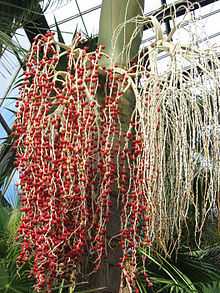Butia paraguayensis
From Wikipedia, the free encyclopedia
| Butia paraguayensis | |
|---|---|
 | |
| Fruit of Butia Paraguayensis | |
| Scientific classification | |
| Kingdom: | Plantae |
| (unranked): | Angiosperms |
| (unranked): | Monocots |
| (unranked): | Commelinids |
| Order: | Arecales |
| Family: | Arecaceae |
| Subfamily: | Arecoideae |
| Tribe: | Cocoeae |
| Genus: | Butia |
| Species: | B. paraguayensis |
Butia paraguayensis is a species of palm tree found in the Gran Chaco region of South America. Its natural range runs from Mato Grosso do Sul and Parana in southern Brazil through Paraguay to northern Argentina.[1]
Description
Butia paraguayensis is most commonly a solitary dwarf parm usually forming a subterranean trunk although great variability is shown with some specimens forming large trunks above ground.[1] [2]
The leaves range from a grey-green to blue color and the petioles are spineless.
In common with Butia yatay with which it shares the same range, the female flowers are much larger than the male.[1]
References
- ↑ 1.0 1.1 1.2 http://www.butia.co.uk/Butia%20paraguayensis.html
- ↑ http://www.pacsoa.org.au/palms/Butia/paraguayensis.html
This article is issued from Wikipedia. The text is available under the Creative Commons Attribution/Share Alike; additional terms may apply for the media files.